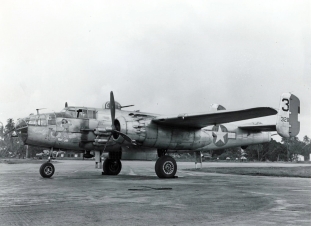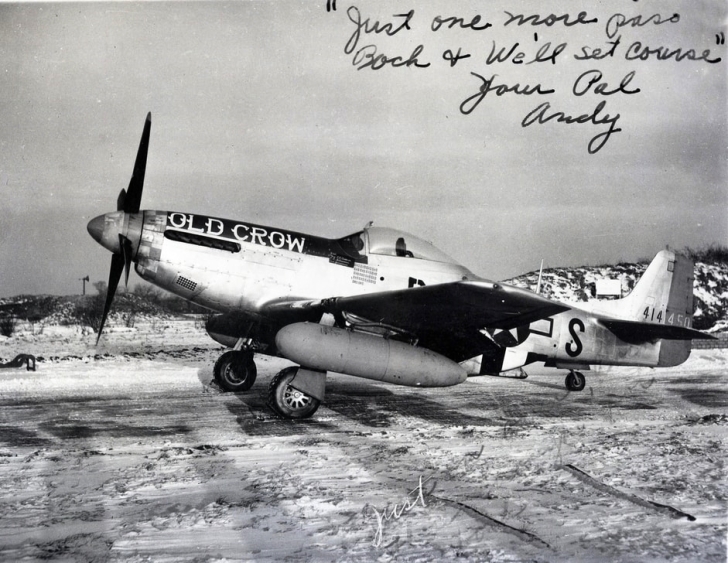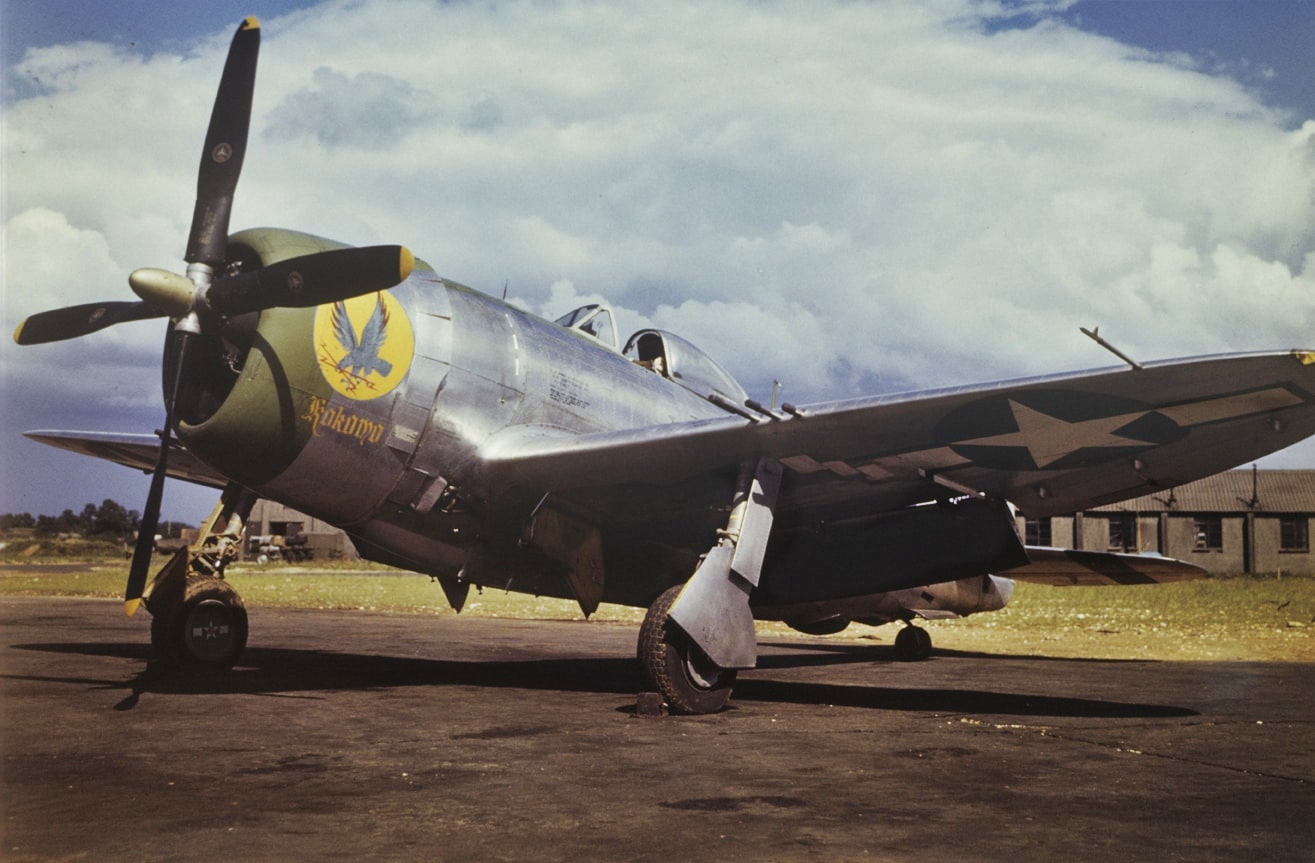
Category: Army Air Force
Bats Outta Hell
Grasshoppers
An Unfortunate Fortress

Some planes are unlucky; 42-5846 of the 535th Bomb Squadron, 381st Bomb Group at RAF Ridgewell was once such aircraft. In approximately six months of combat service, this B-17F, nicknamed “Tinker Toy“, had more than its fair share of sorrows. On one mission, the navigator was killed by flak. A later mission was even more harrowing when flak and fighters tore through the formation, resulting in the pilot killed and the copilot wounded. The flight engineer, after pulling the body of the pilot from his seat, flew the aircraft back to England, where he and the injured copilot made a successful landing.
On the 20th of December, 1943, Tinker Toy’s run of less than stellar fortune ran out: the plane was engaged by a BF-109 who, after raking the B-17 with gunfire, collided with its target, and both planes went down locked together. Seven men died in the Fortress, and the other three crewmen were taken prisoner.
Thus ended the saga of an unlucky B-17, but such tales were well-known to the bomber crews of the 8th Air Force during World War II.
Pair of P-51s
The first photo shows Bob standing on a wing. Bob (Chilton) has a great job: he is North American’s test pilot and, therefore, gets to fly brand-new Mustangs for his daily bread. The second photo shows one of the birds that may have been given the O-K back at the factory by Mr. Chilton himself (a P-51B, 42-106829 of the 362nd Fighter Squadron).
The Inconspicuous Banshee
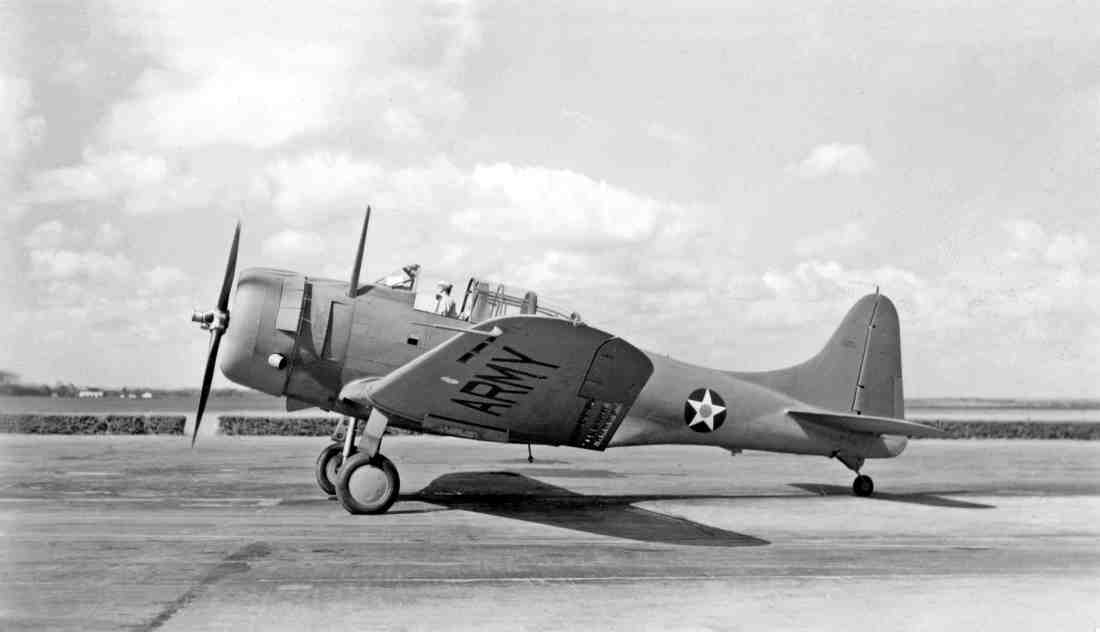
The term “one of the unsung aircraft of WWII” is a sobriquet that, in my opinion, is often overused. Namely, most of the planes tagged as unsung/neglected/overlooked were aircraft either built in very few numbers, were ineffective (see: built in very few numbers), or worse, lousy at their job. For such machines, being labeled “unsung” would imply they had done things worth singing about but were somehow overlooked by ill-informed or biased critics.
Then we have the A-24 Banshee, an airplane that did plenty to sing about but is indeed as non-sung of a WWII aircraft as they come.
Based on the A-24’s record as a frontline combat aircraft, it should be very well known then and now: They were in service throughout America’s involvement in the war and every theater of operations. They were rugged, reliable, and effective. Lastly, they were built in sufficient quantities (almost 1,000) to make a difference.
Nevertheless, the A-24 is little known outside the world of WWII airplane aficionados/geeks. The reasons are simple: Mustangs, Lightnings, Thunderbolts, and other pursuit ships also made excellent multi-role fighter bombers and eventually took away much of Banshee’s reason for being. Furthermore, when discussing WWII light bombers, the Marauders, Havocs, and Mitchells will always come first to mind. Moreover, all of these planes – fighters and bombers – were built in the tens of thousands. Yes, almost 1,000 Banshees were built, but that number pales compared to the volume of better-known aircraft manufactured during WWII. The A-24 – despite its effectiveness – was simply not going to be as famous as many other aircraft.
Unfortunately, the A-24 Banshee has never received the attention it deserves. Not only has it long been overshadowed by the other fighters and bombers of the Army Air Forces, it also had the misfortune to have a far more famous look-alike cousin, the preeminent ship-killing aircraft of WWII, the SBD Dauntless.
Jane Adams: 1940s Actress, Glamour Girl, and (obviously) Jet Test Pilot
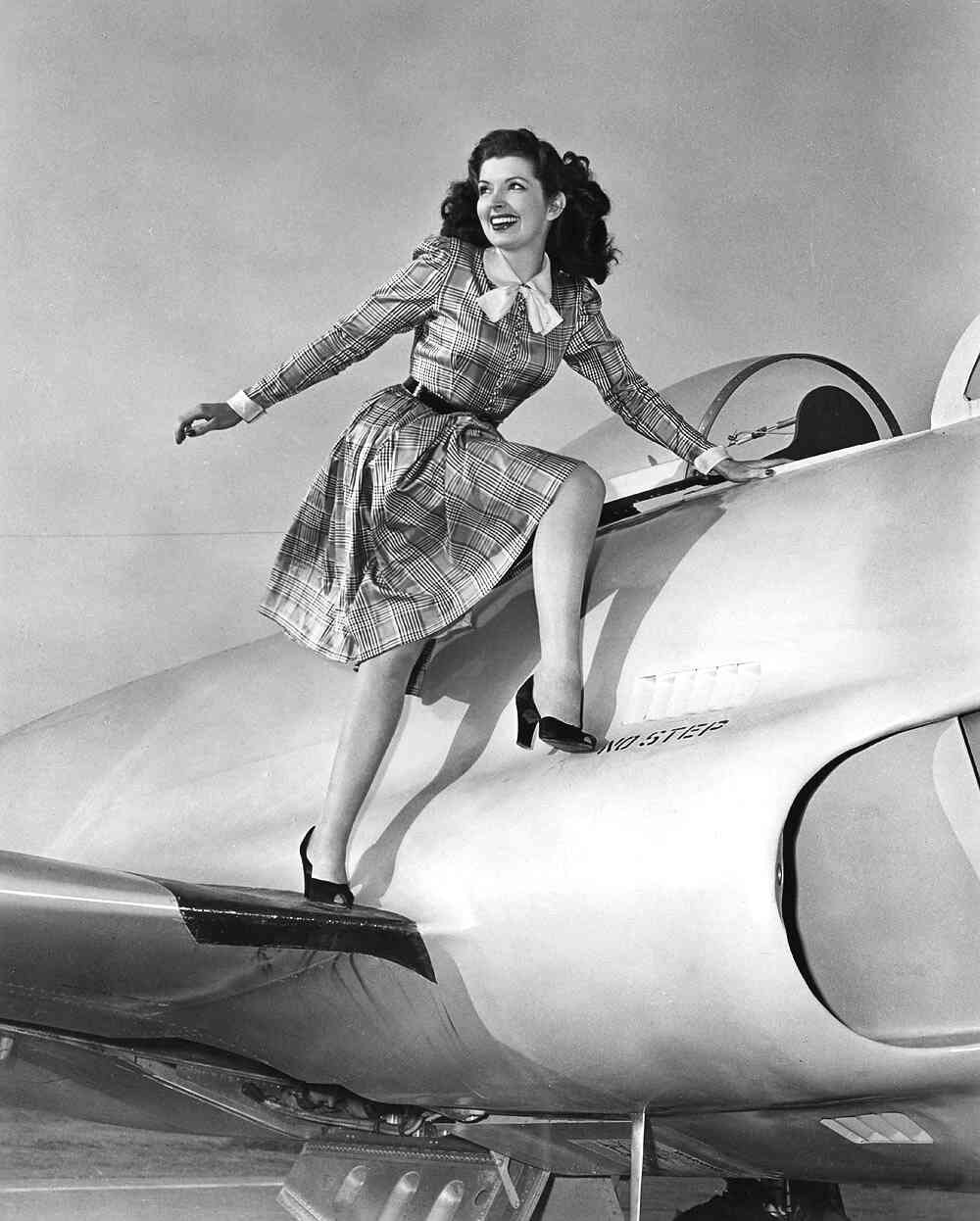
If avid fans of outrageously inexpensive films were to go back in time to the late 40s & early 50s, one actress they would instantly seek out would be Jane Adams, queen of the B-film screen. Whatever picture genre one fancied – westerns, horror, sci-fi, or romance, to name but a few – Jane Adams was your gal.
Alas, her career in more mainstream pictures never materialized, but that’s okay; she was easy to look at and made movies that, with a ready supply of cocktails, still make great late-night entertainment. (Hard to go wrong with features such as House of Dracula, Rustler’s Round-Up, and Tarzan’s Magic Fountain)
As seen in this publicity photo, Adams (real name Betty Bierce) was another of the charming women that aircraft manufacturers considered vital in selling flying machines.
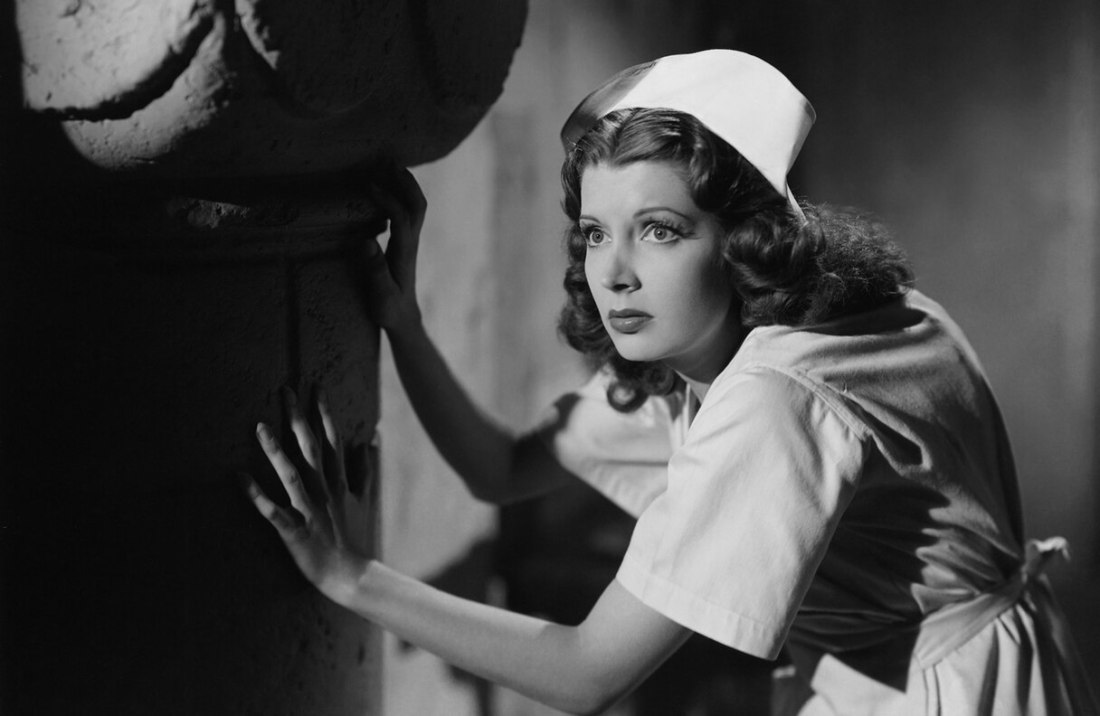
Jane Adams as “Nina, The Hunchbacked Nurse” in House of Dracula (1945).
Post-War Life for Catalinas
Boeing’s Forgotten Bomber, the B-50
Although a solid aircraft in every respect, the B-50 was overshadowed (figuratively and literally) by the giant B-36, and the newer and more exciting jet aircraft then taking to the skies.
December 7, 1941
92nd Fighter Squadron, 1947

As the jet aged dawned other USAAF squadrons were transitioning from props to “stovepipes” (as the jet engine was commonly called), the 92nd in Hawaii was defending the islands with the tried and true P-47 Thunderbolt. In fact, the “Jug” provided Hawaii’s air defense until well into the 1950s. This is not at all surprising: jets were needed in Korea, and besides, were someone to launch an aerial attack on Hawaii, it could not have been with jets (there were as yet no Soviet jet bombers, and the MiG-15 posed no threat to far-off Hawaii).
For fans of the B-25 Mitchell
Men and Mustangs: The 357th Fighter Group
One of the perks of being a general is…

…having a fighter plane to call your own. Major General William Kepner was no exception; as boss of the 8th Fighter Command, he got around in style in his P-47 (42-26637) nicknamed “Kokomo”. Here we see it wears the name of an additional city, “Buffalo”. Or, perhaps, it is referring to the animal of the same name. Before the war, Kepner was more associated with balloons & such rather than fighter aircraft. He held six ratings, most rather quaint: command pilot, combat observer, senior balloon pilot, zeppelin pilot, semirigid pilot, and metal-clad airship pilot.
The color photo is courtesy of Bob Livingstone from the sunburnt country, the Land Down Under.
11th Fighter Squadron, Adak, Alaska


Last of the Shark Tails…for now
Stinson Vigilant
The Stinson L-1 Vigilant seen here has had a long and exciting life. Delivered to the Air Corps in 1941, 40-3012 served all over the United States before being purchased by legendary Hollywood pilot Paul Mantz at the war’s end. After decades of work as a camera plane, this airworthy craft now resides in the Fantasy of Flight museum in Florida. This photo shows the plane shortly after its sale to Mantz. The aircraft had last been assigned to the Air Transport Command (ATC) division in Alaska.
This L-1 was a rare bird. Built as 41-18912 for the Army Air Force, it was equipped with floats and redesignated the L-1F. Only a handful were so converted.
26th Bomb Squadron, 1942
Pekoa Airfield, New Hebrides Islands, in the autumn of 1942. A duo of B-17Es of the 26th Bomb Squadron, 11th Bomb Group, await another mission. Note the wing and nose antenna of the SCR-521 radar.
Ground crew reinstall a critical airframe component – the rear half of the aircraft. One can still see on the national insignia that its red center was painted over.
The 26th Bomb Squadron scoreboard and Roll of Honor.
This came with the photos: a hand-drawn version of the same scoreboard. The stars denote action at Hickam Field (the 26th was there December 7), Midway, and the Solomon Islands.
Pursuit ships during the 1941 Louisiana Maneuvers
Bearing the light blue markings of the “friendly forces” during the maneuvers, this P-40 of Hamilton Field’s 77th Pursuit Squadron readies for another mission against the bad guys of the red force.
One of the “bad guys” – a P-38 of Selfridge Field’s 27th Pursuit Squadron.
Mixed bag of B-29 Superforts
Remembering Pearl Harbor
It is late November, 1941, and the men of Hickam Field’s 50th Reconnaissance Squadron pose for a photo to send home for Christmas.
These men could not possibly imagine that even as they smiled at the camera, plans were already underway for their demise. Nor could they imagine that some of them have less than two weeks to live. For those who do survive, it will be an event that will mark them for the rest of their lives.
One man who lived through the attack was PFC William P. Stroud Jr. (4th row, 4th from right in the group photo). A flight engineer in the 50th Recon Sq., Stroud was in the barracks when the attack began. (That barracks, just across the street from the flightline and hangars, bears to this day the scars of the attack.) Despite the madness of that morning, William Stroud kept his cool. Knowing where he was needed most, he raced across the street to the flaming flightline to lend assistance. The squadron’s aircraft were already destroyed, so he grabbed a rifle to get in the fight. And a fighter he was. Following the attack on Pearl Harbor, Stroud won his pilot’s wings, flew B-24s, and in his numerous combat missions earned the Silver Star and Distinguished Flying Cross.
Stroud, soon to be tested in battle, was identified in the group photo by his granddaughter, and it is a pleasure to single out and salute such a courageous young man.
It is well that we remember both those who lived and those who lost their lives that fateful morning. As the original owner of this photograph indicates with his annotations, some would not survive December 7th, but they were never forgotten by those who did.
~”They shall grow not old, as we that are left grow old:
Age shall not weary them, nor the years condemn.
At the going down of the sun and in the morning
We will remember them.” ~
Oddball Aircraft

The XB-24J (42-73130) was a one of a kind aircraft that incorporated the nose of a B-17G. (Translation: Okay, maybe that wasn’t such a hot idea after all.) Due to the numerous “Frankenstein” versions of highly modified B-24s, there must have been something about its design that caused engineers to have fantasies about modifying the aircraft into something it was never intended to be.































